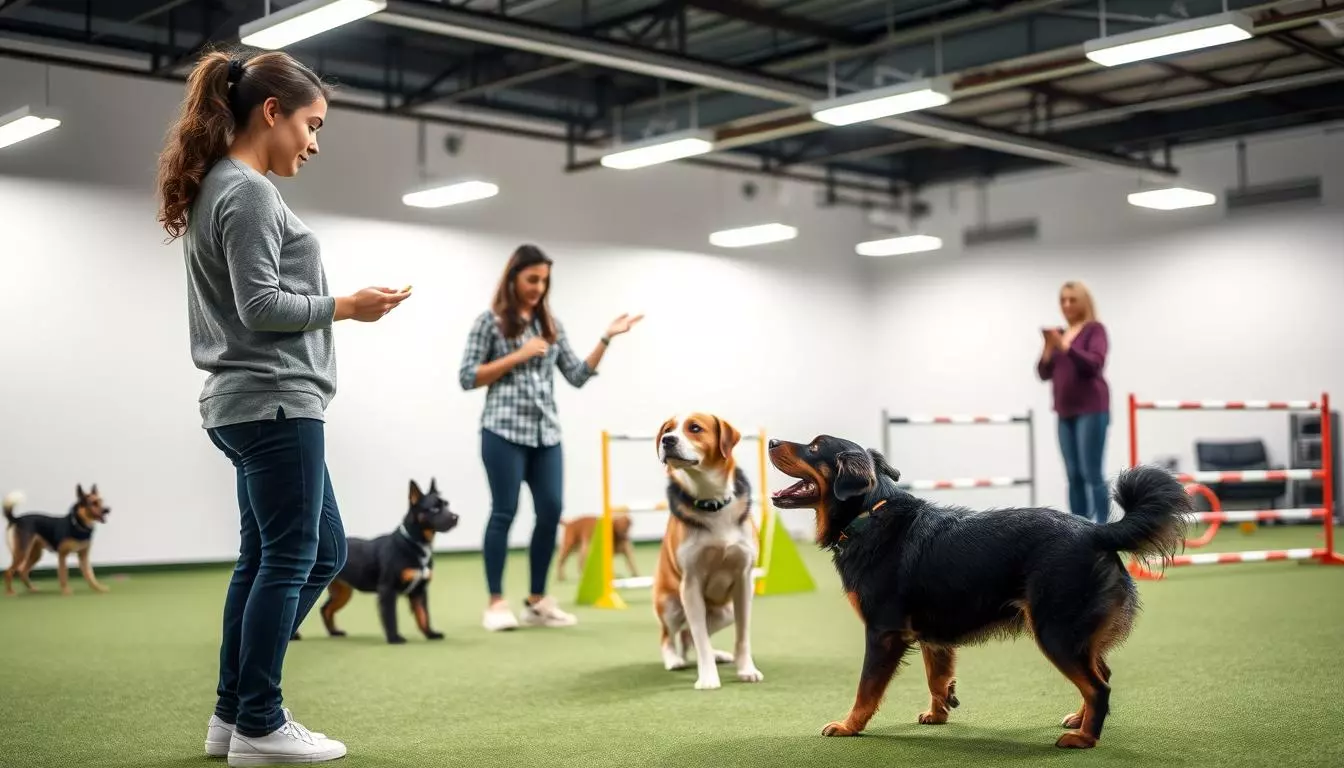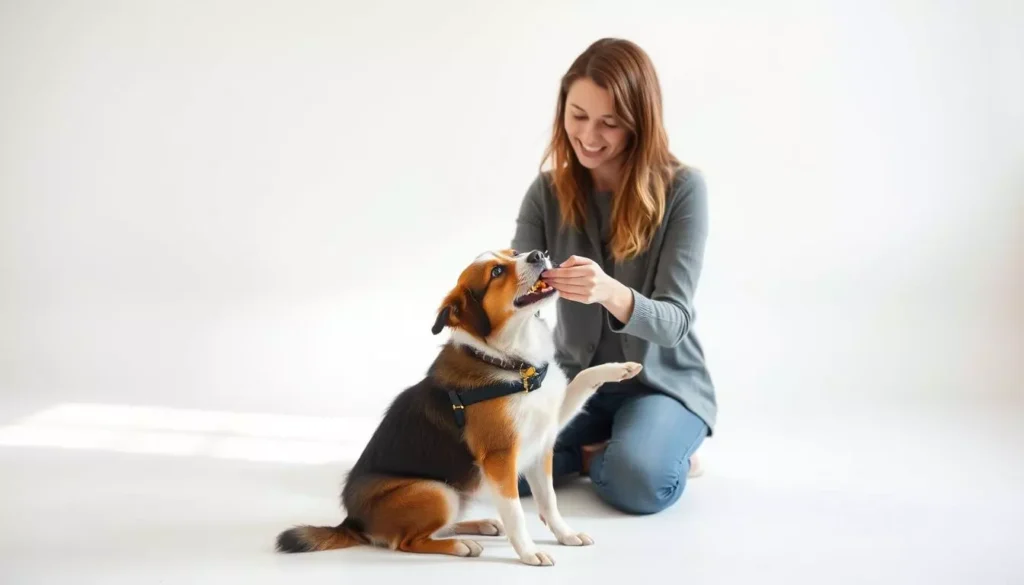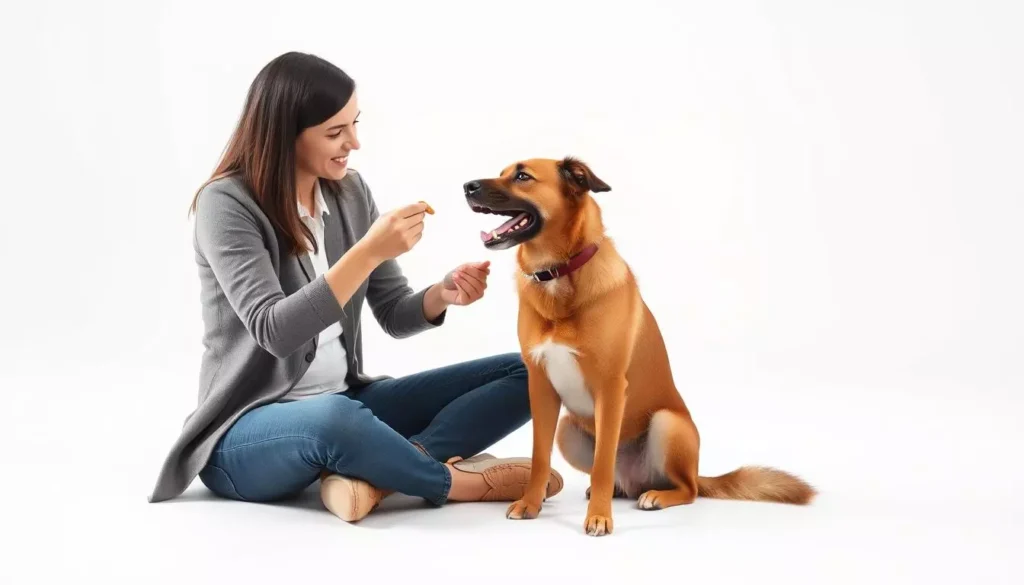As I sat on the living room floor, watching my dog wag his tail, I realized something important. Effective dog training is more than just commands. It's a conversation built on understanding, a dance between canine behavior and the art of obedience training.
Every bark, every paw raised, tells a story of emotions, fears, and hopes. Mastering various dog training techniques isn't just about achieving a well-behaved pet. It's about forging a connection that fosters trust and respect.
In this journey, I discovered that the right tools and methods can transform not only my dog's behavior but also deepen our bond. Let's dive into the world of effective dog training techniques that can help us all become better companions to our furry friends.
Key Takeaways
- Understanding canine behavior is essential for effective dog training.
- Different training techniques cater to various needs and experiences.
- Obedience training helps build a secure and confident dog.
- Mastering effective dog training techniques strengthens the owner-dog bond.
- Early training lays the foundation for a well-behaved pet.
Understanding the A B C Framework in Dog Training
The A B C model dog training is key for dog owners wanting to train their pets well. It focuses on three main parts: Antecedent, Behavior, and Consequence. Each part is crucial for how dogs learn and react to commands.
The antecedent is what happens before a behavior. Knowing these triggers is important. It helps set the stage for your dog's actions.
The behavior is your dog's response to the antecedent. This could be sitting or barking. Understanding this helps me see why my dog acts certain ways. It lets me make better training choices.
The consequence is what happens after the behavior. It can be positive reinforcement, punishment, or ignoring. This part is key to operant conditioning, a basic dog training principle.
Learning the A B C model makes training clearer and more consistent. It helps dogs understand better and strengthens the bond between dog and owner. Seeing these parts helps anyone train their dog more effectively.
Positive Reinforcement: The Key to Successful Training
Positive reinforcement training is a top choice for dog training. It rewards good behavior, encouraging dogs to do it again. Using treats, toys, or praise, I motivate my dog and strengthen our bond.
This method makes training a positive experience. It reduces fear and stress, making our sessions better.
Timing is key in positive reinforcement. Giving rewards right away helps my dog connect their actions with the reward. This clarity makes them more likely to follow commands.
Effective dog training goes beyond rewards. It also means understanding my dog's behavior and reactions.
Using positive reinforcement leads to a well-trained dog. It makes my pet feel confident and happy while learning.
Clicker Training: Enhancing Communication with Your Dog
Clicker training is a great way to improve clear dog communication. It uses a small device that makes a clear sound. This helps me tell my dog exactly when they do something right.
By clicking at the right time, my dog learns what actions get praise. This is key for effective dog training.
The first step is to "charge" the clicker. This means linking the sound to a reward, like treats or praise. Once my dog gets this, I can stop using the clicker as they learn more.
- Helps in establishing clear communication with my dog.
- Increases speed and accuracy of responses.
- Allows for a structured and fun learning environment.
With time and effort, clicker training has made our bond stronger. It helps us understand each other better. This method makes training fun and successful for both of us.
Desensitization and Counter-Conditioning: Managing Fear and Aggression
Managing dog aggression and fear needs effective desensitization and counter-conditioning. These methods help dogs gradually get used to triggers that cause fear or aggression. I can help my dog handle these stressors without feeling overwhelmed.
Desensitization involves exposing a dog to a feared stimulus at a safe level. For example, if my dog is aggressive towards other dogs, I start with a visual separation. Then, I slowly decrease the distance between them. This approach requires patience and moving forward slowly.
Counter-conditioning changes a dog's emotional response to fear-inducing stimuli. It pairs a feared experience with something positive. For instance, giving my dog treats or praise near a trigger can change their reaction to it.
Both techniques need consistency and a clear plan. Watching for behavioral changes helps me know if I need to adjust my approach. Understanding these methods helps me manage my dog's fears and aggression, improving our relationship.
| Method | Description | Outcome |
|---|---|---|
| Desensitization Techniques | Gradual exposure to fear-inducing stimuli at a tolerable level. | Decreased fear responses over time. |
| Counter-Conditioning in Dogs | Pairing fear experiences with positive reinforcement. | Transformation of emotional responses linked to triggers. |
| Management of Dog Aggression | Systematic desensitization combined with positive reinforcement techniques. | Improved ability to cope with triggers, leading to reduced aggression. |
Leash Training for Effective Control
Many dog owners struggle with leash training. Learning the right techniques is key to controlling your dog during walks. The aim is to have your dog walk calmly by your side, not pulling ahead.
This not only improves behavior but also makes walks more fun for both of you.
Immediate feedback is crucial. If your dog pulls, stop walking right away. This teaches them pulling stops the fun. Reward calm behavior with treats, especially early on. This builds positive habits.
Regular practice is vital. Carry treats during walks to reward your dog for walking nicely. As they get used to it, walks become smoother. It's a great way to bond with your dog.
| Leash Training Techniques | Attributions | Benefits |
|---|---|---|
| Immediate Feedback | Stopping when the dog pulls | Teaches the dog that pulling leads to stopping |
| Reward Calm Behavior | High-value treats | Encourages loose-leash walking |
| Practice Regularly | Short and consistent sessions | Reinforces good behavior over time |
Impulse Control Training: Teaching Patience
Impulse control dog training is key to raising a well-behaved pet. It teaches dogs to wait calmly, avoiding bad behaviors like jumping on guests. This training helps them manage their urges in different situations.
Commands like "Leave It," "Wait," and mat training are crucial. They help dogs learn patience, even when there are distractions. Training starts in quiet places to help dogs learn at their own speed.
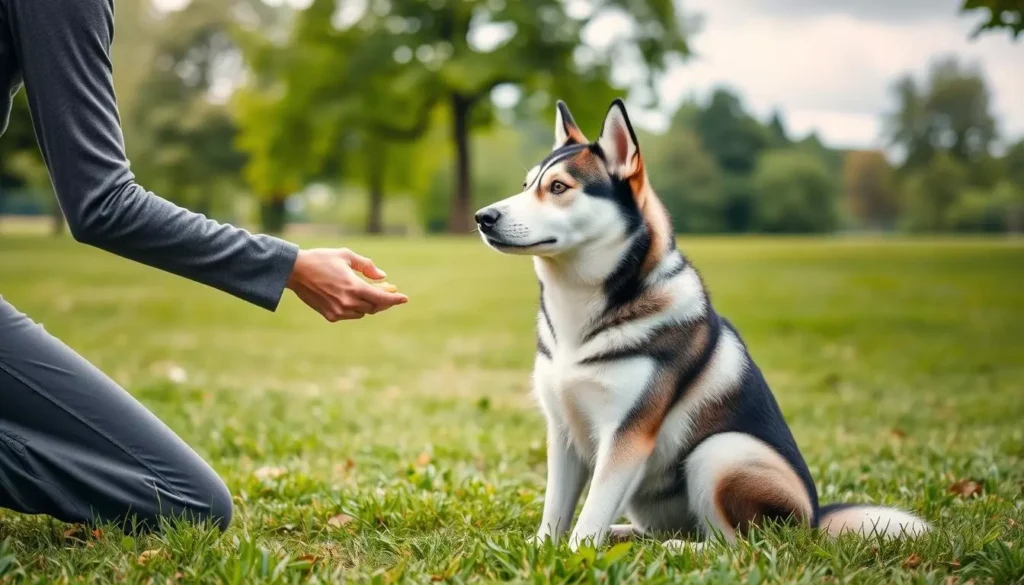
Adding impulse control training to obedience routines boosts positive behavior. As dogs learn to control impulses, the home becomes safer and more polite. With time and patience, dogs can stay calm and composed.
Shaping and Luring Techniques in Training
In my dog training experience, shaping and luring are key. They help teach dogs complex behaviors step by step. Shaping rewards the dog as it gets closer to the action we want. This makes learning fun and interactive.
Luring uses treats to guide the dog into certain positions. It shows them what we expect through visual cues and rewards. Mixing both techniques speeds up learning. Dogs learn better when they see and experience each step.
These methods create a positive learning space. Here's how I use them in training:
- Begin with simple commands to build confidence.
- Slowly add new behaviors while keeping things consistent.
- Use positive reinforcement to keep the learning going.
When to Start Training Rescue Dogs
Knowing when to start training rescue dogs is key for their growth and fitting into a new home. I suggest starting training soon after bringing them home, ideally in the first few weeks. This helps them get used to a routine and their new surroundings.
Training should cover basic commands like "sit," "stay," and "come." These commands are the foundation and improve how we communicate. It's also important to socialize them early. Meeting new people, places, and animals helps build confidence and lowers anxiety.
It's important to slowly introduce them to new things. Playdates, walks in different areas, and visits to pet-friendly stores can make their lives richer. The goal is to make these early experiences positive and fun.
| Training Phase | Activities | Goals |
|---|---|---|
| First Week | Familiarize with home environment | Establish comfort and safety |
| Weeks 2-4 | Basic commands and socialization | Build confidence and basic obedience |
| Month 2 | Exposure to new environments | Enhance adaptability and reduce fear |
Various Dog Training Approaches for Different Needs
Every dog is unique, and they don't all respond the same way to training. I've learned that understanding each dog's special traits is key to their success. This means looking at their individual needs, personalities, and any behavioral issues they might have.
Basic obedience is important, but some dogs need more. They might struggle with fear, anxiety, or aggression. In these cases, it's vital to use training methods that match their specific needs.
Some dogs are naturals at advanced skills, while others need training for service tasks. Recognizing the different abilities and needs of dogs helps me make training sessions both effective and fun for them.
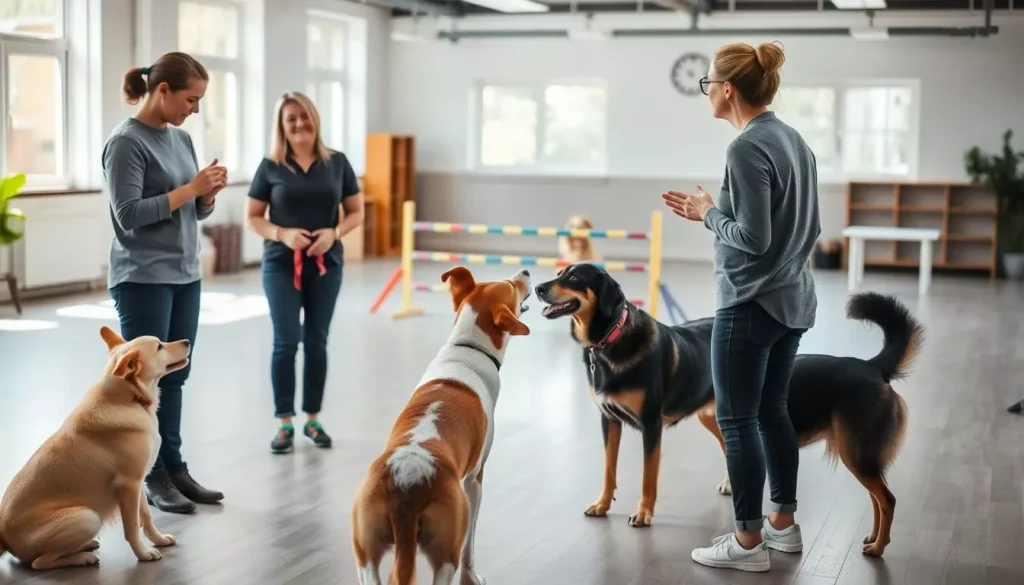
Training Service Dogs: Skills and Techniques
Training service dogs needs a focused approach with specific techniques. These dogs help people with different disabilities. It's key to teach them essential skills for their jobs.
The training covers socialization, managing behavior, and learning special tasks. These tasks help their handlers in daily life.
A good training program makes dogs reliable and calm in many places. Positive reinforcement is key to build trust and good behavior. Dogs must quickly follow commands, which is crucial for their role.
Consistency is important in every step of training. It builds a trustworthy and skilled companion. Training requires patience, clear communication, and a solid foundation in skills. This empowers these amazing animals to do their jobs well.
Guard Dog Training: Instilling Protection Skills
Training guard dogs needs a mix of obedience and natural protection. Socialization is key; it makes dogs confident and reliable. They learn to handle different situations and people.
Teaching dogs to control their impulses is crucial. This skill helps them know when to act and when to stay calm. It's important for them to stay focused, even when things get tough.
As a trainer, I use positive methods and controlled exposure to threats. This way, dogs learn to make smart choices. They become better at protecting their family.
| Training Technique | Purpose | Benefits |
|---|---|---|
| Socialization | Expose the dog to different environments | Builds confidence and reduces fear |
| Impulse Control | Teach the dog to control their reactions | Promotes reliability in various situations |
| Positive Reinforcement | Reward desired behavior | Encourages a strong bond and motivation |
| Controlled Exposure | Safely introduce potential threats | Enhances decision-making in real scenarios |
Guard dog training is about more than just protection. It makes sure the dog is a good friend in all situations. This way, dogs protect their family while staying obedient and safe.
The Importance of Consistency in Training
When I think about training my dog, one principle stands out: the significance of consistency in dog training. A reliable framework enhances communication and creates a predictable environment for my dog. Using the same commands and cues helps my dog understand what is expected.
Without uniformity, dogs may receive mixed signals. This can lead to confusion and stalled progress. Consistency in training not only simplifies the learning process but also impacts the consequences in training. Dogs thrive under clear expectations, making consistent routines indispensable.
Implementing identical rewards or corrections reinforces my dog’s understanding of good behavior. In this context, effective training fosters long-term improvements in behavior. This sets the stage for a closer bond between us.
In my experience, I have noticed two key benefits from consistency:
- Enhanced understanding—Dogs learn faster and more effectively when they receive the same messages.
- Reduced anxiety—Knowing what to expect helps my dog feel secure in our training activities.
The following table highlights the impact of consistency on various training outcomes:
| Training Aspect | Consistent Approach | Inconsistent Approach |
|---|---|---|
| Learning Speed | Fast | Slow |
| Behavior Understanding | High | Low |
| Owner-Dog Bond | Strong | Weak |
In summary, prioritizing consistency in my dog training routines not only helps me communicate effectively. It also leads to profound and lasting changes in my dog's behavior. By sticking to a uniform training approach, I set the stage for success.
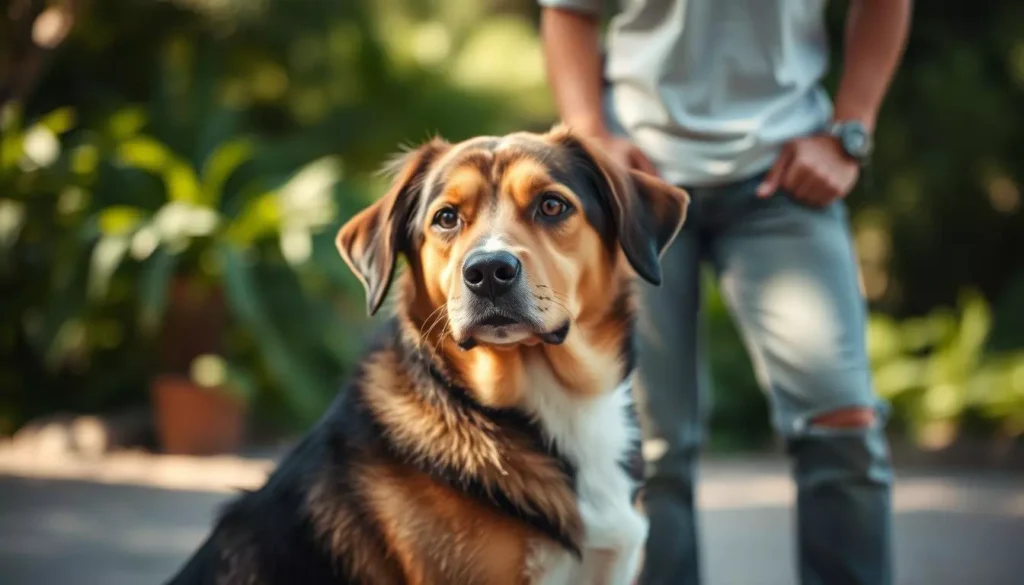
Professional Help: When is it Necessary?
Many dog owners train their pets successfully. But, some situations need a professional's help. Knowing when to seek a dog trainer is key for solving specific training problems.
If my dog shows aggressive behavior, extreme anxiety, or I'm too busy to train, I need a pro. Professional dog training offers customized solutions for unique challenges. They create plans that work faster and better than I could.
Understanding when to seek a dog trainer greatly affects my dog's behavior and our relationship. If I face ongoing issues, getting help from a pro can strengthen our bond and improve obedience.
Building a Strong Bond through Training
Training your dog is key to bond building with dogs. It teaches commands and strengthens your relationship. Every training session builds trust and respect between you and your dog.
A positive dog training relationship is essential for a happy home. It should be fun for both of you, not a chore. Positive reinforcement makes training rewarding and deepens your bond.
Training with excitement and patience makes learning fun. It helps you and your dog grow closer. This journey is about more than just following commands; it's about building a strong connection.
Common Mistakes in Dog Training and How to Avoid Them
In my dog training journey, I've seen many mistakes that slow progress. It's key to know these pitfalls to get better results. One big mistake is being inconsistent with cues. If commands are unclear, it confuses my dog and makes learning hard.
Another mistake is relying too much on punishment. This can make my dog scared and resentful. Good training uses positive rewards to encourage good behavior. This way, my dog feels supported and wants to learn more.
Timing is also very important. If I reward or correct my dog too late, it can confuse them. Being patient and focused helps avoid these mistakes. This makes training more effective.
To steer clear of these mistakes, here's a simple guide:
| Common Mistakes | How to Avoid Them |
|---|---|
| Inconsistency in cues | Use the same commands and gestures for actions. |
| Overreliance on punishment | Focus on rewarding positive behaviors instead. |
| Poor timing | Deliver rewards immediately after desirable actions. |
| Loss of focus | Minimize distractions during training sessions. |
By tackling these issues, I lay a strong foundation for effective dog training. My dedication to avoiding these mistakes improves my results and strengthens my bond with my dog.
Conclusion
Learning dog training is not just about teaching tricks. It's about building a strong bond between a dog and their owner. This article has shown us many ways to train dogs, like positive reinforcement and impulse control. Each method has its own role, helping us train dogs in a way that fits their needs.
As we've seen, using the right strategies consistently is key. This knowledge helps us raise a well-behaved and confident dog. Training that focuses on obedience and emotional support makes our time together better.
In the end, this article teaches us that sticking to these methods leads to great results. By following these principles, I can train my dog successfully. This way, I'll have a happy and obedient pet, and we'll enjoy our training journey together.

